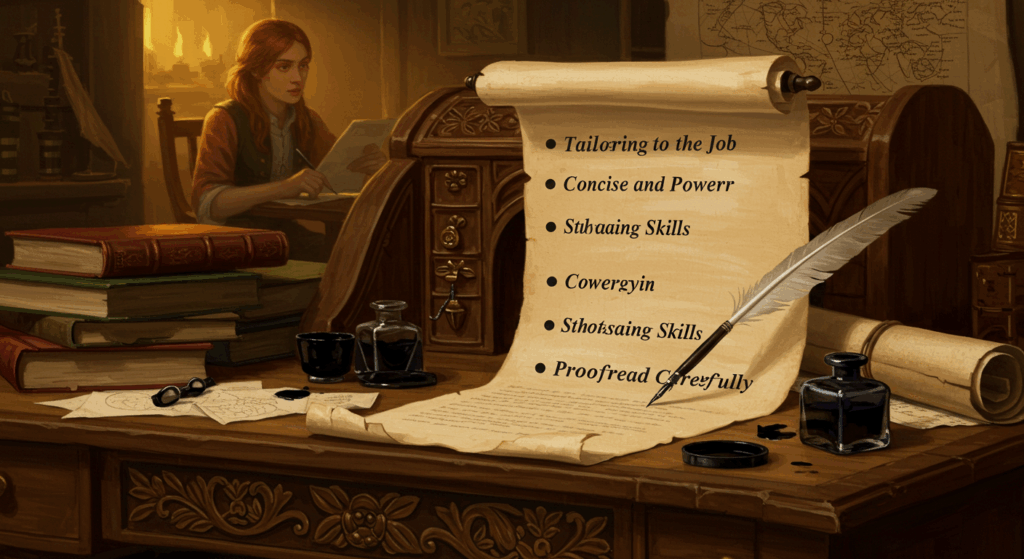Okay, If you’re staring at a job posting and thinking, “Wait… is a cover letter a CV? Are they, like, the same outfit but one’s just wearing a hat?” you’re not alone. The internet can be confusing, recruiters can be mysterious, and ngl, those career advice pages sometimes sound like they were written by an 1800s librarian. So here’s the chill, human version:
A cover letter is a short, personalized note to a hiring manager where you connect the dots between you and this role. A CV (or résumé—depending on where you live) is the factual highlight reel of your experience and skills. They have different purpose, different vibes, and very different differences (lol yes, I said it). But together? They make a strong, swipe-right-level match.
Let’s break it down simply, with a little humor, some real-life examples, and zero outdated jargon. Grab a coffee (or boba), and let’s make this painless.
The One-Minute Answer: The Differences, The Purpose, The Vibe
- Cover Letter = A story. A pitch. The “why me + why this company” note. Its purpose is persuasion and fit. It’s you talking like a person.
- CV/Resume = A list. Your crisp history of jobs, education, skills, and impact. Its purpose is proof and facts. It’s yu presented like data (but still human, promise).
- Are they the same? No. They’re different documents—different differences, different purpose, different tone—working together to say: “I can do the job and I care about your job.”
Think of the cover letter as the movie trailer and the CV as the actual film credits with who did what. Both useful. Both crucial. One’s persuasive and chatty; one’s structured and scannable.
What a Cover Letter Really Is (And Isn’t)
The Purpose of a Cover Letter
A cover letter’s core purpose is to:
- Explain why you’re excited about this role at this company.
- Connect three dots: your background → the job requirements → the company’s goals.
- Add context your CV can’t (like career pivots, passion, culture fit, or results stories).
It’s not a copy-paste of your CV. It’s not your life memoir. And it’s not a template you send everywhere (please, no). It’s a curated intro that says, “Hey, I read your role carefully and I get what you need. Here’s how I’ll help.”
The Vibe Check
- Tone: professional but personable. Think friendly email to a respected person, not… a thesis.
- Length: usually 300–450 words (1 page max). Shorter is better if it’s strong.
- Structure: hook → proof → connection → call to action.
Common Mistakes (and Quick Fixes)
- Mistake: “To whom it may concern.”
Fix: Find the hiring manager’s name or at least the department (e.g., “Hi Product Team”). - Mistake: Rewriting your CV.
Fix: Pick 1–2 examples that match their key requirements and go deeper. - Mistake: Generic fluff (“I’m a hard worker”).
Fix: Add specifics: metrics, project outcomes, tools, timelines, scope. - Mistake: No company-specific detail.
Fix: Reference their product, mission, or recent launch. Show you actually care.
What a CV/Resume Is (And Isn’t)
The Purpose of a CV/Resume
A CV/resume’s purpose is to:
- Prove your qualifications quickly—even when skimmed in ~7–10 seconds.
- Highlight measurable impact (growth, savings, engagement, revenue, time saved).
- Make it super easy for ATS (Applicant Tracking Systems) and humans to find what they need.
The Structure that Works
- Header: Name, title, contact info, portfolio/LinkedIn link.
- Profile or Summary (optional): 2–3 lines about your strengths + domain focus.
- Experience: Reverse-chronological. Bullet points that show action + result.
- Skills: Tools, languages, frameworks relevant to the job.
- Education/Certs: Relevant and recent, with highlights if strong.
- Projects (optional): Especially if transitioning or early career.
CV vs. Resume… and the Global Twist
- In the US/Canada, “resume” is the common term: 1–2 pages, tailored to the role.
- In the UK/Europe/Asia, “CV” often means the same thing as “resume” (1–2 pages).
- In academic/research/medical contexts, a CV can be much longer (multi-page) with publications, conferences, etc.
Either way, the differences between the cover letter and the CV remain consistent: story vs. stats, persuasion vs. proof, narrative purpose vs. record purpose.
Cover Letter vs CV: The Differences That Actually Matter
1) Voice and Tone
- Cover Letter: conversational, human, slightly sales-y (in a good way).
- CV: factual, structured, skim-friendly.
2) Content Focus
- Cover Letter: behavior + motivation + context. Why you care, why you fit.
- CV: responsibilities → impact. Use metrics and concrete examples.
3) Customization Level
- Cover Letter: hyper-customized per application. Always.
- CV: customized per application too (yes), but you can keep a strong base version.
4) Length and Format
- Cover Letter: 3–5 short paragraphs. One page max.
- CV: 1–2 pages (unless academic CV). Scannable sections and bullets.
5) How They’re Read
- Cover Letter: by humans to gauge intention and communication style.
- CV: by both ATS and humans to verify qualifications and alignment.
If you remember nothing else: differences = story vs stats, purpose = why vs what, examples = narrative case study vs bullet point outcomes.
Examples You Can Steal (Lightly) for Your Cover Letter
A Clean Opening (Hook)
“Hi [Hiring Manager/Team],
When I saw your posting for a Growth Marketing Associate, I literally bookmarked it mid-Netflix. I’ve grown B2C signups 2.3× in 9 months at my current role, and your focus on community-led growth (that Discord playbook 👀) is exactly the kind of challenge I love.”
Why this works: it shows energy, relevance, and a comcrete result. It hits purpose (why this company), hints at differences (your angle vs general candidates), and tees up your examples.
A Punchy Middle (Proof)
“At [Company], I led a 4-person pod for lifecycle experiments (email/SMS/in-app), running 18 tests per quarter. Our best win: a triggered onboarding sequence that increased D7 retention by 14% and reduced CAC by 12%. I also partnered with product to build event tracking that uncovered a drop-off at Step 2—fixing it recovered $180k ARR.”
Why this works: specific, measurable, cross-functional. The numbers make it real.
A Confident Close (Connection + CTA)
“I’m excited about [Company]’s bet on product-led growth and your recent [feature/launch]. I’d love to bring my testing brain and calm-in-chaos energy to your growth team. If it’s helpful, I can share a short teardown of your onboarding and a few hypotheses. Thanks for reading—I’d be happy to chat.”
Why this works: humble flex, company awareness, and a clear ask.
Examples That Level Up Your CV Bullets
Let’s rewrite some common bullets to show differences in quality and purpose.
Weak:
- Responsible for email campaigns and reporting.
Stronger (Outcome-first):
- Drove lifecycle growth by launching segmented email/SMS campaigns, improving D7 retention +14% and reducing CAC −12% over 2 quarters.
Weak:
- Managed social media accounts.
Stronger:
- Built a creator-led TikTok strategy that lifted organic reach +220% and contributed 18% of monthly signups (from 0%) in 5 months.
Weak:
- Worked with engineers on tracking.
Stronger:
- Partnered with engineering to implement event tracking (Mixpanel), surfacing a Step-2 funnel drop-off; shipped UI fix that recovered $180k ARR.
Formula you can copy:Action verb + what you did + tool/context + quantified outcome + time frame
This aligns to the CV’s purpose (proof) while the cover letter tells the story behind those examples.
The Purpose Behind Both Documents (Why Recruiters Care)
1. The Purpose of a Cover Letter (zoomed-in)
- Shows you can communicate clearly (real-world skill).
- Reveals your decision-making and motivation (culture fit).
- Reduces perceived risk (“We won’t need to spoon-feed this person.”)
- Proves you read the JD (low-key, it’s shocking how many don’t).
2. The Purpose of a CV (zoomed-in)
- Validates that you meet the must-haves.
- Surfaces your biggest wins quickly.
- Fits ATS keyword checks (job title, tools, core competencies).
- Helps the team visualize where to plug you in.
TL;DR: The differences exist because they serve different purpose—and you need both to show both sides of the “hire me” coin.
How to Create Both in One Sitting (A Simple, Not-Overwhelming Workflow)
- Start with the JD (job description).
Highlight the top 5 requirements. Note tools, outcomes, and team context. - Draft your CV bullets around impact.
Use the formula and pull 8–12 crisp bullets that hit those 5 requirements. - Write your cover letter last.
Pick 1–2 examples from your CV that match the JD’s priorities and narrate them. Connect to the company’s mission/products. - ATS sanity pass for the CV.
Mirror their language where accurate (e.g., “lifecycle marketing,” “SQL,” “Figma prototypes,” “sales enablement”). - Human sanity pass for the cover letter.
Read it out loud. If it sounds robotic, edit. If it sounds like a text to your old professor (respectful but warm), you nailed it. - Name your files like a pro.
First-Last-Role-Company-CV.pdfandFirst-Last-Role-Company-Cover-Letter.pdf. - Final check:
- CV length 1–2 pages?
- Cover letter under 450 words?
- Both tailored to the same JD?
- Contact links working?
Mini Templates (Steal and Personalize)
Cover Letter Template (Purpose + Examples baked in)
Hi [Name/Team],
I’m excited to apply for the [Role] at [Company]. Your focus on [mission/product/initiative] resonates with my experience [quick connection—industry, user problem, toolset].
At [Current/Recent Company], I [what you owned], delivering [quantified outcome] by [how you did it], partnering with [teams/tools]. A relevant example: [1–2 sentence mini-case that mirrors their JD].
I’m especially drawn to [Company] because [specific detail you noticed—launch, feature, value]. I’d love to bring [your strengths] to help [team outcome]. If helpful, I can share [portfolio/teardown/code sample].
Thanks for your time—looking forward to connecting,
[Your Name]
[LinkedIn/Portfolio]
CV Bullet Bank Prompts (to spark ideas)
- “Increased X by Y% by doing Z (timeframe).”
- “Reduced cost/time by X using Y + Z.”
- “Built [thing] that enabled [team] to [impact].”
- “Partnered with [team] to ship [feature], leading to [metric change].”
Quick FAQs (Because Yes, We All Have Them)
Q: Do I really need both?
A: If the application asks for both, yes. If it says “cover letter optional,” a sharp one can differentiate you. It shows effort and fit—especially for competitive roles.
Q: Can I reuse the same cover letter?
A: Reuse the skeleton, sure. But always customize the opening and the examples to the company’s needs. That’s the whole purpose.
Q: How long should a CV/resume be?
A: Most roles: 1 page early career, up to 2 pages if you’ve got 6+ years of solid, relevant impact. Academic CVs are the exception (they can be much longer).
Q: PDF or Word?
A: PDF, unless the employer explicitly requests another format. Keep the file size small and the layout clean.
Q: Do I mention salary requirements?
A: Only if asked. Otherwise save that for the later stages.
Q: Is a cover letter a CV?
A: Nope. They’re different documents with different differences and purpose, working together to tell your story and prove your value—with examples to back it up.
Mistakes That Quietly Cost Interviews (and What To Do Instead)
- Vague verbs. Replace “helped” with “drove,” “owned,” “launched,” “built,” “designed,” “scaled,” “optimized.”
- No metrics. Add numbers (even directional): %, $, time saved, users affected, frequency.
- Formatting chaos. Keep consistent spacing, fonts, dashes, and date formats. Your future self (and the recruiter) will thank you.
- Walls of text. Use short paragraphs in cover letters and crisp bullets in CVs. Think mobile reading.
- No “why them.” In your cover letter, mention something specific about the company—product, mission, market, feature, or news. (Yes, do a quick skim; five minutes tops. You can do it while Spotify plays lo-fi.)
How They Work Together in Real Life (A Tiny Narrative)
Imagine you’re applying to a Product Designer role at a fintech startup.
- Your CV shows: Figma, design systems, usability testing, 3 shipped features, a checkout redesign that improved conversion +9%.
- Your cover letter tells the story: why fintech, why design for trust, how your last usability test uncovered a friction pattern that maps to their current flow, and a quick note that you’ve sketched 2 hypotheses for their onboarding.
The differences in purpose here are elegant: the CV is your receipts; the cover letter is your conversation. Both use examples—one in bullets, one in narrative.
A Note on Tone (Because We’re Not Robots)
If you’re Gen Z or Millennial (or just allergic to corporate jargon), it’s okay—great, even—to sound like a real person. Keep it respectful and clear, but don’t sand off your entire personality. A smidge of warmth, a tiny aside (“hmm,” “ngl”), or a wink to culture (Netflix, Spotify, the eternal chaos of dating apps) can make you memorable. Just… don’t overdo it. It’s a spice, not the whole dish.
A 10-Point Final Checklist (Differences, Purpose, Examples—All Covered)
- I know the core differences: cover letter = story; CV = stats.
- I honored the purpose: CL persuades; CV proves.
- I used examples: strong, relevant, quantified.
- My cover letter is < 450 words: punchy and specific.
- My CV bullets start with action verbs: and end with outcomes.
- I tailored both to the JD: keywords, responsibilities, tools.
- I included a little humanity: but kept it professional.
- I proofread aloud: no typos (ok, maybe one cute one).
- I exported to PDF with clean filenames: easy for recruiters to find.
- I asked for the next step: “Happy to chat / share a teardown.”
Final Takeaway (aka the “friend pep talk”)
No, a cover letter is not a CV. They’re different on purpose, with clear differences in tone, structure, and goal. Your cover letter is the “here’s why I care and how I’ll help” story; your CV is the “here’s proof I can deliver” dossier. Put them together with a few sharp examples, and you’ve basically built a tiny, persuasive funnel that gets you from “applicant #381” to “invited to interview.”
You’ve got this. Seriously. Open the JD, pick two wins to spotlight, and write the first sentence. Then the next. Hit send. And if your inner critic pops up, tell them you’re busy building the life you want—one brave application at a time.
Now go apply for that role you’ve been lurking. Future-you is cheering.









